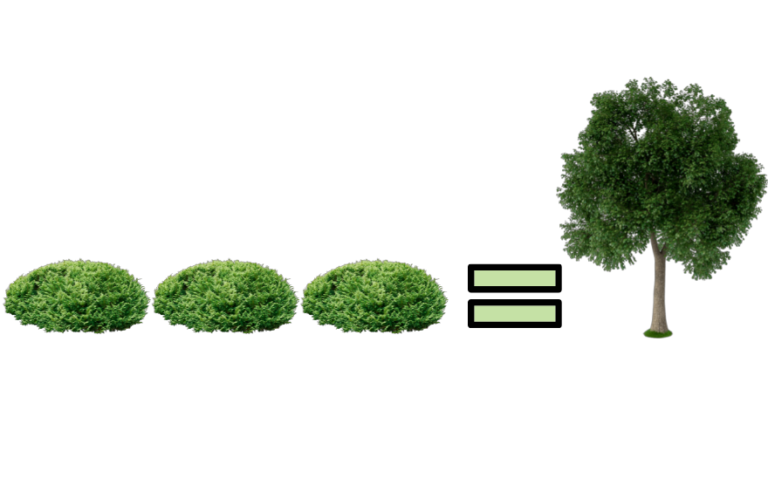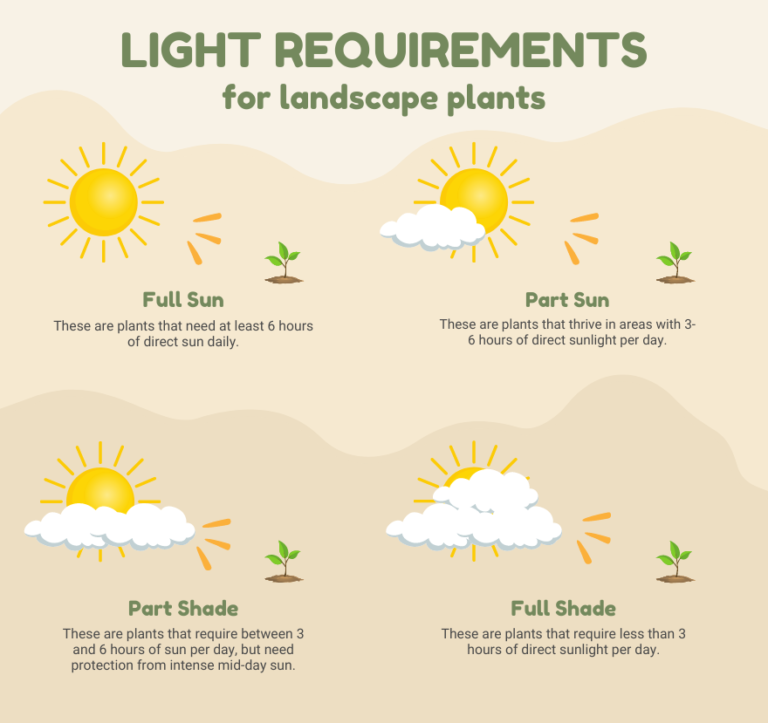Learn to design a landscape refresh that increases your property value and overall landscape aesthetics.
Whether you are a landscaping beginner or landscape professional, landscape refreshes can be challenging to do on a budget while increasing property values and overall landscape aesthetics. That’s why we’ve created 5 Tips for the creation of a professional landscape refresh:
1. Understanding Balance
2. Designing Landscape Curvature
3. Designing with Geometric Shapes
4. Creating a Focal Point
5. Selecting the Right Plants
Balance is often tied directly to comfortability. As a homeowner, you will often shift or move some furniture to better balance a room, or relocate some décor until equilibrium is met on a shelf or table. Whatever it may be, balance seems to put humans at ease, and it’s only once something is out of balance that things become very noticeable.

Balance also plays a role in every landscape refresh. Having too many plants on one side of residence and not enough on the other can look strange and out of place. Balance in a landscape is achieved when an equal amount of foliage (also known as leaf growth) is installed on both sides of a property. Notice something very important, we used the term equal amount of foliage, not equal plants. This is an important point to highlight when trying to figure out how to do landscaping on your own.
When creating a landscape design with equivalent foliage mass, landscape ideas can include both symmetrical ideas or asymmetrical ideas. Let’s pause for a second, because a lot was just covered in that last sentence. Foliage mass? Symmetrical balance? Asymmetrical balance? What does all of this mean?
Foliage mass may sound complex, but in all reality, it’s just some “cool” language landscapers use to sound extra smart. Foliage mass is as simple as the amount of leaves on a plant. For example, a shrub might have 100 beautiful leaves (no need to count the leaves on every plant, just eyeball it), while a small tree may have 300 beautiful leaves. Yes, we got lucky that both the shrub and tree had beautiful leaves. Anyways, if we wanted to plant these beautiful leafy plants in the same garden bed, we’d ideally like them to be balanced, therefore we’d have to manipulate our design a little bit to create that balance. In this particular example, we’d actually take one of the trees placing it on one corner, and then take three of the shrubs placing them on the opposite corner. When doing some intense foliage mass calculations for this example, we calculate the following:
1 Tree = 300 leaves
3 Shrubs = 100 leaves (shrub one) + 100 leaves (shrub two) + 100 leaves (shrub three) = 300 leaves
It can be seen that both the three shrubs and one tree balance each other out with 300 leaves a piece.

Balance can occur in two ways, symmetrically or asymmetrically. Symmetrical balance is achieved when installing the exact same plantings on one side of the view as the other side. This type of balance is more commonly seen amongst temporary homes or residences that have a yard or home that is symmetrical.
Asymmetrical balance on the other hand is achieved by creating plantings that have equal foliage but are not a mirror-image of each side. The asymmetrical landscape is less formal than the symmetrical look, therefore, due to the designs lack of rigidness, it is significantly more common in a landscape refresh.
The last point on landscape balance is this: “Foliage mass isn’t even the tip of the iceberg when it comes to landscape refreshes and balance.” If you really want to get technical, additional factors can be added to the landscape balance equation:
Each of these items are added factors worth considering, but won’t make or break your landscape refresh design. Obviously, being the “insanely awesome landscapers” that we are, we still recommend you try to balance foliage color by matching red leaves to other plants with red leaves or pairing up rounder shaped plants with other rounder shape plants… but we don’t want to overwhelm you, so feel free to reach out to us if you have more in-depth questions about landscape balance.
When renovating a landscape, people are always trying to figure out what landscape ideas are the least expensive while adding the most value. A curvilinear landscape design is that answer. It doesn’t come with any additional costs. It’s a design most residential landscapers use to minimize abrupt corners and simplify maintenance around the residence.
When creating your own curvilinear (curvy) design, you should use extended, sweeping curves to outline the planting beds. This look is definitely considered more informal and will commonly impose a more relaxed mood throughout the outdoor space. We aren’t shutting down the desert retreat that chooses to have no added landscape plantings or the more formal geometric shapes found in modern landscapes, but we do commonly encourage our clients to go with the middle between the two extremes if they are looking to create the most value for their home.

Once you’ve decided to use the curvilinear design for your landscape refresh, begin choosing what plants belong in that landscape. When doing a “curvy” design we recommend a few of the following guidelines that we were taught early in our landscaping careers.
We aren’t going to sugarcoat it, geometric gardens aren’t our specialty, so we aren’t going to in-depth on the topic. Even without it being our specialty, we still have a few words of wisdom for all you DIYers looking to utilize geometric shapes in laying out your landscape refresh.
In all reality, geometric shaped landscapes follow all the same rules as the curvilinear design. These designs still utilize balance, repetition, variety, and texture. The only difference is, the lines are commonly straight instead of curvy. Geometric landscapes are most commonly rectangles, but squares, triangles and a combination of all of these shapes can also be used. These landscape designs are attractive, clean, and require a little more design to maximize the beauty. Here are our two tips to achieving high quality results:
When creating your very own landscape refresh, you should plan out areas that will catch the attention of any passerby. At Three Timbers, we add or highlight a couple of focal points in every landscape design. Focal points are the areas that immediately catch the eye when walking up on a residence or entering a landscape space.
Focal points, although splendid, should be kept to a minimum. For example, when landscaping the front yard, one of the major focal points is the front door. Therefore, you may add large shrubs on each side of the entrance or install large planters with some color to grab a guest’s attention. The point is, putting a focal point on the front door isn’t only beautiful, it’s also functional. It doesn’t make sense to highlight the beat-up basketball hoop in the front or the doggy door going into the garage. Create focalization for the items you want to look at (the front door, a direct view from the kitchen window, a perfect view from the patio, etc.) on a daily basis, and then design the landscape to draw less dramatic attention to those other items.
The best way to create focalization on a budget is by using trees or shrubs that flower. When living in place like Scottsdale, Arizona, you can even be more creative with your focalization. Try designing your landscape to incorporate a flowering tree that serves as a focal point all summer long, and then once those blooms die off in the fall, have another plant that blooms in the fall waiting somewhere else in your landscape that can serve as a new focal point. The cool thing about using plants as focal points, is that the focal points can move throughout the landscape every season.
When using plants as focalization, be sure that any area that gets highlighted by a very noticeable plant is worthy of attracting attention and is kept clean!
After going through all the nitty-gritty details associated with landscape design: landscape balance, the shapes included in the landscape design and highlighted focal points throughout the residence; it’s finally time to start selecting the plants that will make up the bulk of your landscape look. This article won’t actually explain the exact species of plant you should install, but we will explain what to look for when picking out your plant type.
When selecting plants for your landscape refresh, start by grouping plants according to their mature growth size. For example, a landscape design may include different groups of groundcovers, shrubs, and trees; each containing a different purpose and design attribute to complete the landscape. On top of mature growth size, check the following attributes for each plant you choose prior to install:

When selecting plants for your landscape refresh, start by grouping plants according to their mature growth size. For example, a landscape design may include different groups of groundcovers, shrubs, and trees; each containing a different purpose and design attribute to complete the landscape. On top of mature growth size, check the following attributes for each plant you choose prior to install:
Ground covers are smaller plants that are used as a substitute for grass. Grass may be hardy, but it doesn’t commonly grow under low growing trees or in densely shaded locations. In these hard growth locations, use ground covers as a plant that adds variety and erosion control.
Vines can be trained to sprawl up walls, climb trellises, or beautify fences. Vines can be a good substitute for natural privacy fences on concrete slabs or paver patios where space is limited.
Dwarf shrubs are commonly used are the main residence, especially under windows to allow more open site lines. They are also used as low-growing hedges in between properties or as a ground cover across a hill. Dwarf shrubs are most aesthetically pleasing when grouped in large quantities to fill a landscape bed.
Medium sized shrubs can be used as focal points to hide sharp corners or edges along one-story homes. Medium shrubs are also good choices for if an untrimmed hedge is needed or a border needs to be created within the landscape design. Lastly, medium shrubs are an effective plant used as a background filler behind smaller plants placed along the landscape edge.
Large shrubs are also used as corner plants, but for larger homes (2+ story). Large shrubs are commonly planted between residences as a natural substitution for a fence or block wall. In open, exposed areas that get battered with harsh winds, large shrubs are also useful as a windbreaker to decrease wind and dust.
The most common purpose for small trees is shade. Small trees provide shade on hot summer days while also providing some variety in a landscape refresh. Commonly more expensive, but well worth it when planted in groupings or in locations where large trees wouldn’t fit.
Just like the small trees, large trees are used for shade and focal points. These trees take up large spaces, making for a solid plant choice in large landscape areas.
Specialty Plants… These may include ornamental grasses, palms, fruit trees, cactus, and succulents. These plants come in a variety of shapes, sizes, and colors, so time should be spent studying these plants prior to install. Most landscape designs include one or many of these specialty plants because of their variety and beauty. Consider using one of these specialty plants as a focal point in your front or back yard.
Landscape refreshes have become an essential part of how landscaping can increase a home owners property value. We hope that the basic skills listed in the above article will help you make add additional features to your landscape design that goes beyond the average landscape beginner. If you have any questions at all, Three Timbers is always a simple call away. We will happily give you advice or mock up our own landscape refresh design for you if in Scottsdale, AZ or the SouthWest Metro, Minnesota.
Fill out the form below and a Three Timbers representative will contact you shortly.
Website Design by JBC